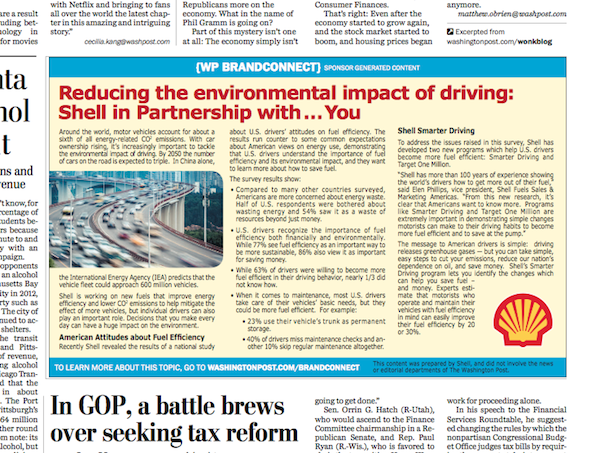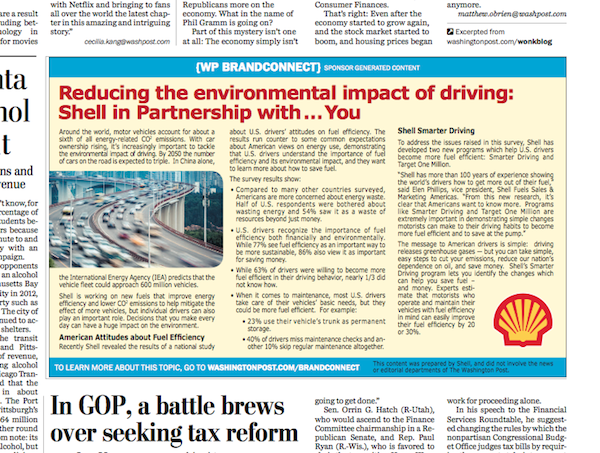Join us Dec. 1-3 in New Orleans for the Digiday Programmatic Marketing Summit

When is a print advertorial a native ad? The Washington Post published an ad for Shell in Thursday’s print edition that it’s touting as its first native ad in print. Shell used the ad, which ran on A13, to tell readers about the work it’s doing to improve energy efficiency. A nearly identical version ran online.
Many will no doubt see the Shell ad as a classic advertorial type ad that publications have run in print forever. But the Post said the Shell execution is true native because it’s integrated among editorial stories on the page. It’s labeled “sponsor generated content” and visual cues of background shading and fonts that are different from the surrounding articles.
“Unlike print advertorials of the past, the content does not appear as an insert or in standard ads; instead, it is integrated among editorial stories on the page featuring background shading and ‘sponsor generated content’ labeling,” Post spokeswoman Jennifer Lee said. Kevin Gentzel, the paper’s chief revenue officer, added, “It is designed and labeled to be differentiated from the newsroom-generated journalism on the page, hence the coloration and slugging. The idea here is to start the conversation where Washington decision-makers start their day and continue the conversation with our readers online.”
Like many publishers, The Post, which was bought by Amazon founder Jeff Bezos last year, has been banking on native advertising to help its digital revenue make up for declining print advertising.
Using a commonly accepted definition of native as an ad that takes the form of editorial and mimics the look and feel of the host publication’s editorial, the Shell example misses the mark, though. While the ad may be native in terms of its placement, the ad itself reads like an advertorial, with its promotional copy and bland stock photo. The Post has an internal department that creates native ads for clients, but for this ad, the content was prepared by Shell, which goes to show how much advertisers need publishers’ help in creating native ads. But that’s another story.
The embrace of native has created some tension with the editorial side, though. Editors have been wary about ads that too-closely resemble editorial content, opening up the possibility of reader confusion. And while readers have become accustomed to intrusive ads on the Web, print, with its greater attention to the reader experience and higher ad prices commanded, is still treated with (relative) kid gloves. The New York Times and The Wall Street Journal, for example, have reluctantly started running native ads online but haven’t in print yet.
At least in the case of the Shell ad, the bland copy and blaring design ensure that readers won’t confuse it for editorial.
Joe McCambley, co-founder of The Wonderfactory, said it’s hard to do native in print, which doesn’t have the audio, video and promotional tools of Web publishing. Print’s tool set consists only of design, art and writing to pull in a reader.
“I’m not saying it can’t be done in print, but you really have to work really hard to make someone pay attention,” he said. “It’s a godsend that the Washington Post made it look as horrible as it is, because no one will mistake it for editorial. This, it’s just an island in the middle of the page.”
More in Media

AP makes its archive AI-ready to tap the enterprise RAG boom
It’s a strategy that should secure its future as an information data repository for the AI era, and widen its customer base to include more enterprise clients by meeting their AI needs,

Inside Reuters’ agentic AI video experiment
Reuters is experimenting with using an AI agent to speed up its video production process, and hired its first AI TV producer.

Shopify just became the biggest company to launch a Substack newsletter
Shopify is the first company of its kind — an e-commerce platform — to take the plunge into Substack.






